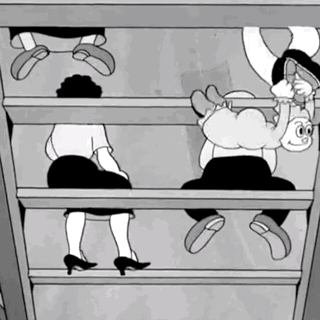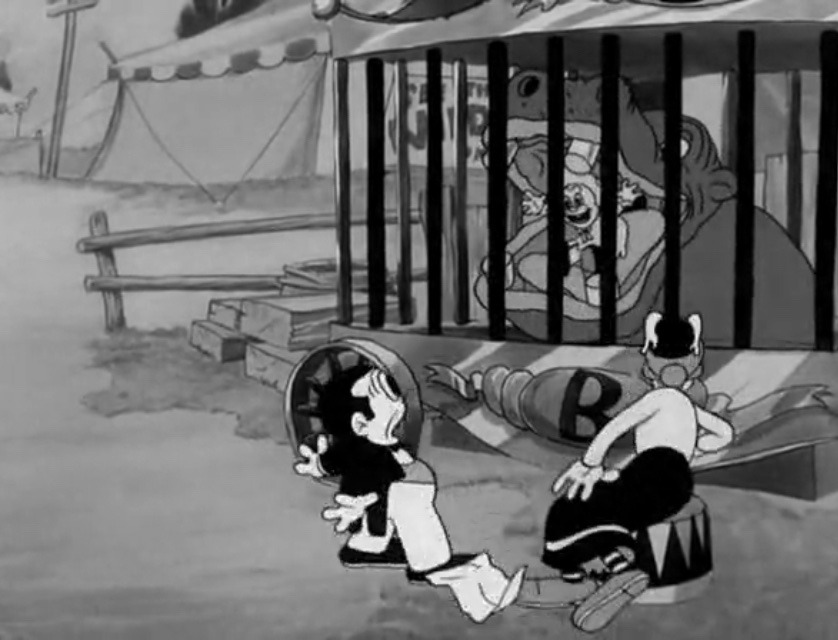Release date: November 8th, 1934
Series: Looney Tunes
Director: Jack King
Starring: Jackie Morrow (Buddy), Jane Withers (Junior)
A slightly more eventful I Love a Parade, Buddy’s Circus details the ins and outs of, well, Buddy’s circus—including saving a baby in peril.
Without a doubt in your mind, you know the title of the cartoon you’re watching as we open to Buddy and various circus animals floating in a hot air balloon. The animation is very jaunty and upbeat, always a plus. Via telescope, Buddy spots a sign that reads “BUDDY’S CIRCUS WILL ARRIVE AT 2:00PM”. Sure enough, a quick check of the watch asserts it’s 2:00. Buddy drops an armful of stakes, an octopus hammering them in—a trip back to our Harman-Ising memory lane! The synchronization with the hammering animation, sound effects, and music is very well done. The hot air balloon hits the surface and literally morphs into a tent, eager patrons filling it up in no time.
We’ve a collection of gags... and, of course, REALLY following Harman-Ising tradition, the bulk of them are racist caricatures. Of course. Start out with Buddy playing elephants’ tusks like a marimba, tugging on their tails and playing them like a pipe organ as they exhale steam through their trunks.
Here’s where things get ugly and you desperately wish for it to be over. Buddy introduces the “Ubangi Boys” (an unsavory sign advertising them as the duck bill twins), telling the audience they’re going to dance and play. One of the twins plays the other’s skirt like a xylophone, occasionally hitting his head. Another act introduces “OSCAR the Ubangiphone—‘he plays a mouthful’”, another gross stereotype using his tongue as a needle to play a record. “ELASTIKO the India-rubber man”, reused from I Love a Parade, stretches and bounces himself around like a rubber hose. The animation does deserve commending, it’s very smooth and bouncy, but this entire sequence is very cringeworthy and not enjoyable. The stereotypes thankfully come to a halt once “ABESTO the HUMAN STOVE” swallows a flame, a pan, and an egg. A quick x-ray displays the egg is indeed frying.
Finally we arrive to the main attractions of the show. Buddy leads a marching band, accompanied by a trombone playing kangaroos (and its trumpeting joey), a man playing a cymbal on another guy’s hat, a man chuffing a cigar and blowing smoke rings for lions to jump through, lions jumping on his stomach and causing another ring to be expelled. Another man holds onto a rope with his teeth, lifting up higher and higher... until a signature terrifying Jack King closeup displays his dentures slipping loose and the man plummeting to the ground below.
A baby in the crowd cheers (“Wee! Wee! Wee!”), dropping its popcorn under the bleachers in the process. Some attentive parents the baby has as he swings from various legs like Tarzan in the jungle. The animation is smooth and fun to watch, possessing some weight and spacing to it. As the baby goes to retrieve its fallen popcorn, an elephant sucks it up in its trunk instead, bouncing the baby happily.
“TRY SPIFFS’ HAMS” covers the screen, the advertisement moving away as we see its plastered on an acrobat’s butt—cleverly crude. There’s also a nice gag of the crowd watching the acrobat swing, their bodies and heads moving in opposite directions. A man licks another man’s ice cream cone each time he sways, eventually biting his finger. The oblivious glee as the perpetrator continues to watch the spectacle while the victim angrily glares on is priceless.
Elephants complete a dance routine, accompanied by the wandering baby from before. Albeit nothing too special, it is entertaining to watch the baby straggle behind in poor time as the elephants flawlessly execute their routine. Elsewhere, more gross black caricatures make another appearance as a man swings from two rings, revealed to be nose rings from other acrobats. The acrobat loses his grip and falls on a piece of board, situated on top of a pedestal like a seesaw. Predictably, the other half of the makeshift seesaw is inhabited by the mischievous baby, who flies into the air from the impact.
The baby lands itself right into the hands of an acrobat routine, more acrobats piling below the swinging baby. FINALLY the baby’s mother notices, about damn time! She cries “JUNIOR!”, and as the acrobat show falls apart, Buddy also takes notice. The music score in this scene is lovely, jaunty, high energy, and playfully urgent. Buddy and the mother both scale the poles to the supportive netting, buddy lassoing the baby to safety, who pulls off the acrobat’s clothes above.
Safely caught by the net, but not for long. The baby, Buddy, and the mother ricochet off the net and spring back up, all clinging to the acrobat for safety. They swing, knocking a man off his bicycle during a tightrope act. Buddy and the mother cycle frantically beneath the hanging baby, the bike crashing into a pole and all three ejected out of the tent and elsewhere outside. A nice angle of the baby falling directly into an animal cage.
Buddy and the mother scale down a giraffe, shredding off all its markings on its neck in the process. The two look for the baby, but it isn’t anywhere to be found. Buddy tries to console the weeping mother, dabbing her eyes and blowing her nose for her (what a gentleman!). Yet, never fear! The baby is safely in the clutches of a hippo’s mouth. The mother reunites with her child, iris out on all three holding hands and dancing merrily.
As far as Buddy cartoons go, this is one of the better ones. With that said, my biggest problem is (as always) the gross racist stereotyping, just one after the other. It ages poorly and doesn’t rise any laughs. The entire first half, including that sequence, felt rather slow and dull, but things quickly picked up once the baby entered. The animation was nice and the music served as a safety net for any poor scenes—the fact that this cartoon has been restored is always a lucky plus. Easier to analyze details that way. I’d say MAYBE go for it—if you do, go to the second half. There’s still a brief scene involving racial stereotypes which is gross, but the baby stuff happens after that. Probably one of the more high energy cartoons, just be wary and view at your own discretion because of the stereotypes.
Link!













No comments:
Post a Comment